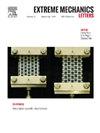Computational and experimental design of fast and versatile magnetic soft robotic low Re swimmers
IF 4.5
3区 工程技术
Q2 MATERIALS SCIENCE, MULTIDISCIPLINARY
引用次数: 0
Abstract
Miniaturized magnetic soft robots have shown extraordinary capabilities of contactless manipulation, complex path maneuvering, precise localization, and rapid actuation, enabling them to cater to challenging biomedical applications such as targeted drug delivery, internal wound healing, and laparoscopic surgery. However, despite their successful fabrication by several different research groups, a thorough design strategy encompassing the optimized kinematic performance of the three fundamental biomimetic swimming modes at miniaturized length scales has not been reported until now. Here, we resolve this by designing magnetic soft robotic swimmers (MSRSs) from the class of helical and undulatory low Reynolds number (Re) swimmers using a fully coupled, experimentally calibrated computational fluid dynamics model. We study (and compare) their swimming performance, and report their steady-state swimming speed for different non-dimensional numbers that capture the competition by magnetic loading, nonlinear elastic deformation, and viscous solid–fluid coupling. We investigated their stability for different initial spatial orientations to ensure robustness during real-life applications. Our results show that the helical ’finger-shaped’ swimmer is by far the fastest low Re swimmer in terms of body lengths per cycle, but that the undulatory ’carangiform-like’ swimmer proved to be the most versatile, bidirectional swimmer with maximum stability.
快速多用途磁性软性低Re游泳机器人的计算与实验设计
微型磁性软机器人在非接触式操作、复杂路径机动、精确定位和快速驱动方面表现出非凡的能力,使它们能够适应具有挑战性的生物医学应用,如靶向药物输送、内部伤口愈合和腹腔镜手术。然而,尽管有几个不同的研究小组成功地制造了它们,但到目前为止,还没有一个全面的设计策略,包括在小型化长度尺度上优化三种基本仿生游泳模式的运动学性能。在这里,我们通过使用完全耦合的实验校准的计算流体动力学模型,从螺旋和波动低雷诺数(Re)游泳者中设计磁性软机器人游泳者(MSRSs)来解决这个问题。我们研究(并比较)了它们的游泳性能,并报告了它们在不同的无量纲数下的稳态游泳速度,这些无量纲数捕获了磁加载、非线性弹性变形和粘性固流耦合的竞争。我们研究了它们在不同初始空间方向下的稳定性,以确保在实际应用中的鲁棒性。我们的研究结果表明,螺旋形的“手指形”游泳者是目前为止在每周期体长方面速度最快的低Re游泳者,但波浪形的“血管状”游泳者被证明是最全能的,具有最大稳定性的双向游泳者。
本文章由计算机程序翻译,如有差异,请以英文原文为准。
求助全文
约1分钟内获得全文
求助全文
来源期刊

Extreme Mechanics Letters
Engineering-Mechanics of Materials
CiteScore
9.20
自引率
4.30%
发文量
179
审稿时长
45 days
期刊介绍:
Extreme Mechanics Letters (EML) enables rapid communication of research that highlights the role of mechanics in multi-disciplinary areas across materials science, physics, chemistry, biology, medicine and engineering. Emphasis is on the impact, depth and originality of new concepts, methods and observations at the forefront of applied sciences.
 求助内容:
求助内容: 应助结果提醒方式:
应助结果提醒方式:


